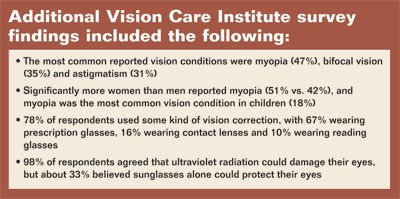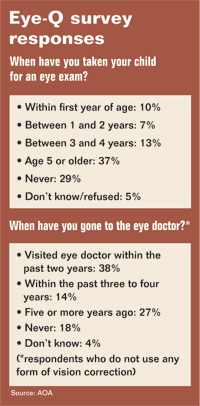Most Americans not seeking regular vision care, despite recognizing its importance
Most Americans consider vision care a priority, but few take advantage of available resources or seek regular eye exams, recent survey results showed.
One survey was conducted by Harris Interactive, an independent market research firm, on behalf of the Vision Care Institute of Johnson & Johnson Vision Care, Inc. Investigators contacted a nationally representative sample of 3,716 U.S. adults using online- and telephone-based questionnaires.
Another survey, the American Eye-Q, was created by the American Optometric Association (AOA) in conjunction with Opinion Research Corporation (ORC). ORC conducted random telephone interviews of 1,000 American adults.

Vision Care Institute survey
The Vision Care Institute survey found that 94% of respondents considered vision care a high priority. However, 35% had never taken their child to an eye doctor, 25% had not had an eye exam within the past 2 years, and 14% did not have a regular eye care professional, according to a Johnson & Johnson press release.
“[The survey findings are] a cause for concern, because adults and children who are at greater risk for certain eye conditions and diseases are not receiving proper diagnosis and treatment,” Derrick Artis, OD, of Vistakon, Division of Johnson & Johnson Vision Care Inc., said in the release.
AOA survey
According to an AOA press release, the AOA survey found that 44% of parents do not know that a child’s behavioral problems can indicate vision impairment. The survey also showed that only 10% of parents follow the AOA recommendation to have infants examined before the first birthday. The survey estimates that 29% of all children have never been to an eye doctor.
“Vision is a key factor in the growth, development and daily performance of children,” said Andrea Thau, OD, in the AOA press release. “One of the most important things parents can do to help ensure their child’s ability to learn is to take them for a comprehensive eye exam.”
Because vision changes generally occur in adults and children without notice, children should visit an eye care professional at least every 2 years, according to the AOA press release. To help ensure eye health, children should have regular eye exams starting at 6 months of age.
The AOA survey also showed that adults should take better care of their own eye health, said the AOA. Americans consider their eyesight as one of their most valued attributes; however, 62% of those surveyed who do not currently wear glasses or contacts have not been to an eye doctor in the past 2 years. Nearly 20% of adults have never been to an eye doctor.
 |
Demographic trends
Researchers also found significant differences among ethnic groups in the Vision Care Institute survey.
Although 94% of Asians agreed that vision care is a priority, 36% said they felt they did not need an exam unless they had a vision problem. Asians were also least likely to believe vision correction would significantly improve daily activities, such as driving, reading and working.
Whites were most likely to be able to define common vision problems, such as myopia and presbyopia. But despite most white respondents (71%) stating that annual eye exams are important, 25% said they had not visited an eye care professional within the last 2 years.
Black patients were most likely to consider vision care a high priority, with 50% indicating vision care is as important as other health issues. But these patients were least likely (21%) to have a regular eye care professional.
Hispanics were most concerned about worsening vision, with 27% stating they were strongly concerned over worsening vision, compared to 15% of respondents overall. But Hispanics were least likely to have seen an eye care professional in the past year, according to release.
Patient education
Access to eye care, transportation and affordability are all factors that may affect eye care for various demographics. However, Thomas L. Steinemann, MD, a spokesman for the American Academy of Ophthalmology, emphasized that patient education is a crucial factor.
“Maybe people are not familiar with eye disease,” he said in an interview. “There are resources out there … It is incumbent upon us as eye care professionals to get the word out and serve.”
The National Eye Health Education Program (NEHEP), funded by the National Eye Institute, designs educational programs on diabetic eye disease, glaucoma and low vision.
“NEHEP has a program targeted just toward Hispanic patients with respect to eye disease, because, as a group, they are at risk for blinding eye disease,” Dr. Steinemann said. “The Hispanic population is growing, but also their risk for eye disease and blinding complications is higher.
“Another demographic shift that is on us is the aging baby boomers,” Dr. Steinemann continued. “Some people are predicting that in the next 25 years we will see literally a doubling of the number of people with vision impairments. We are going to be living longer, and many of us will be living with degenerative conditions, including, perhaps, blinding eye conditions such as age-related macular degeneration.”
For more information:
- The American Optometric Association can be reached at 243 N. Lindbergh Blvd., St. Louis MO 63141; (800) 365-2219; fax: (314) 991-4101; Web site: www.aoa.org.
- The Vision Care Institute can be reached at 7500 Centurion Pkwy., Jacksonville, FL 32256; (800) 874-6690; fax: (904) 928-5806; www.thevisioncareinstitute.com.
- Thomas L. Steinemann, MD, can be reached at MetroHealth Medical Center/Ophthalmology, 2500 MetroHealth, 3rd Floor, Cleveland, OH 44109; 216-778-4253; fax: 216-778-7863; e-mail: tsteinemann@metrohealth.org.
- For more information on the National Eye Health Education Program, go to www.nei.nih.gov/nehep/.
- For a free copy of the Americans’ Attitudes & Perceptions About Vision Care Executive Summary, write to VisionCareSurvey@visus.jnj.com.
